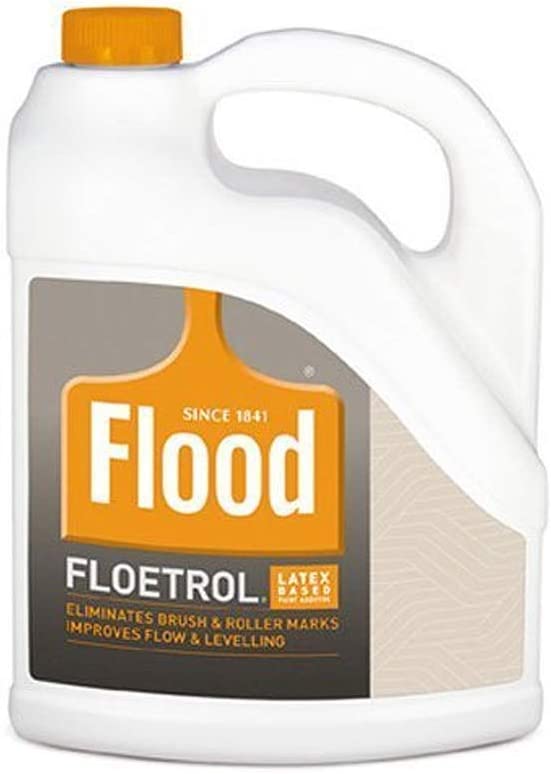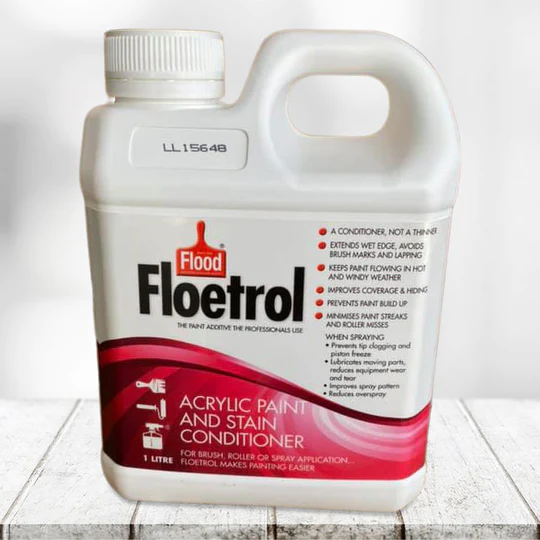Last Updated on March 16, 2024 by Masha Eretnova
Floetrol for acrylic pouring is now a very trending medium and the amount of questions constantly increases. Is it the best way even if it is not a real pouring medium?
Why can not just use water? I can relate to all your worries so let’s just follow official guidelines and practical knowledge that I will share below.
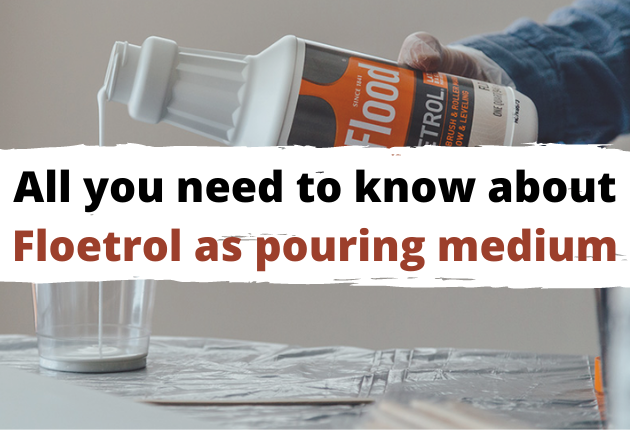
How much floetrol to add to acrylic paint? An excellent way is to follow official instructions and mix 1 part of Floetrol to 2 parts of acrylic paint. The best ratio for your needs depends on the paint you use, the paint consistency you want, and your experience. There are also some recipes with silicone and water.
You can be very excited about acrylic pouring. The only BUT is the price of professional mediums. You can absolutely use floetrol for acrylic pouring and there are at least 10 reasons why you should try it right now. I will cover them below as 9 Best Floetrol substitutes too.
Table of Contents
This article may contain affiliate links. It means NO extra costs for you, but small comission for me to support this website. Thank you!
What is Floetrol?

Floetrol is a paint conditioner, a latex paint additive for water-based paint.
Floetrol is made of binder (Polymer emulsion) and water.
Floetrol wasn’t explicitly made for acrylic pouring.
But Floetrol pouring medium became a very affordable and effective pouring medium due to its properties: floetrol improves paint flow and adhesion, creates larger cells without damaging paint quality, and also never causes cracking.
Floetrol for acrylic paint is the best option for beginners who are learning pouring techniques and are not ready to buy expensive artist-grade mediums.
It is also an excellent ingredient for all your experiments!
Floetrol is used for interior and exterior works, for spraying and, now, for acrylic pouring.
This medium is great for acrylic pouring because it makes painting dry slower, which means you don’t have to be in a rush and can enjoy the process and create a real masterpiece.
Floetrol may cause skin and eye irritation. Make sure your work with gloves and do not touch your face while mixing floetrol and pouring.
What is the difference between Australian Floetrol and US Floetrol?
Australian Floetrol has different ingredients than American Floetrol and it is not available on Amazon (you can still buy it on eBay/Etsy).
It is very easy to differentiate them: US floetrol has an orange and white label, while Australian floetrol has a red and white label.
Basically, Australian Floetrol is a thinner, acrylic-based medium that has a stain conditioner in its composition, and a milky white texture it was made for acrylic paints and stain.
American Floetrol is thicker, has a whitish color, and is made of latex paint.
It is also known that Aussie floetrol creates much more cells by itself than the US option (US floetrol almost created no cells without silicone additives).
The downside is that Australian floetrol is more expensive, especially if you will order it in the US through eBay or Etsy. The official manufacturer claims that there is no difference between them, while practice and crafters reports state otherwise!
If you don’t have access to Australian floetrol, you can try to mix thinner US floetrol and experiment with the consistency.
Why use floetrol in acrylic pouring? 11 Benefits Of Using Floetrol For Acrylic Paint
Here are 11 reasons why you may want to use floetrol for acrylic paint for pouring:
- FLoetrol is cheaper than some alternatives.
- Floetrol creates larger cells even if you do not use silicone.
- does not affect paint quality, especially pigment like water does.
- improves flow, thinning paint without damaging paint properties.
- provides a smooth, spray-like application
- increases paint adhesion
- prevents the negative impact of environmental factors (hot and cold temperatures or high humidity)
- prevents cracking. This is vital for your painting. The temperature and humidity are very likely to lead to cracks. Fixing cracks can be a hard task and it will be discouraging, for sure.
- easy to mix and use
- extends dry time and allows you to create more effects
- does not affect the paint’s aging
All of them make floetrol an excellent pouring medium.
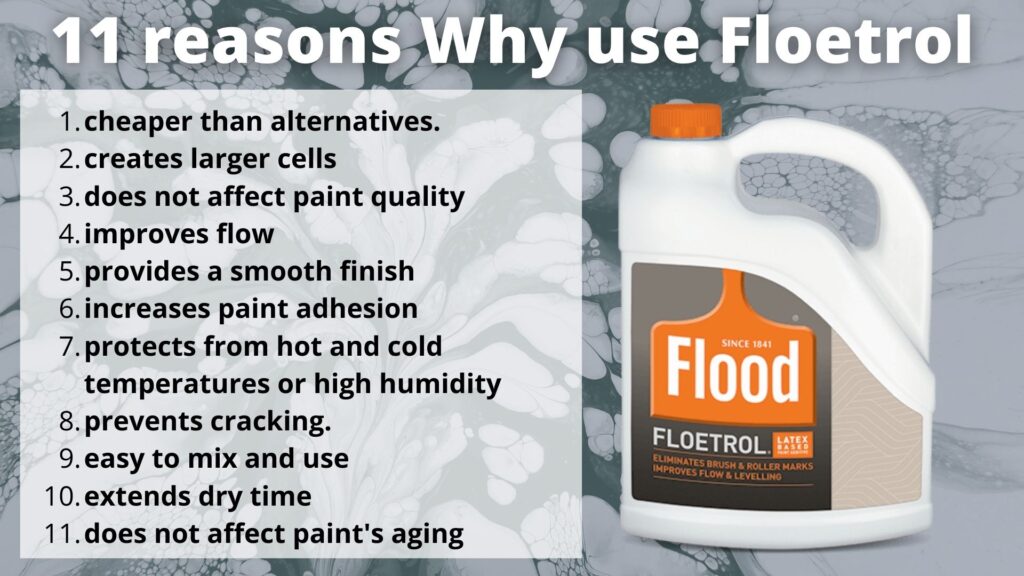
How to use floetrol
Floetrol is used for water-based paint with brushes, HVLP spray guns, or airless paint sprayers depending on your needs. In this article, we only talk about using floetrol for acrylic paint pouring.
Limitations:
- If your paint is a high gloss paint you will want to consider mixing the Floetrol with water as floetrol can reduce the gloss of your coating if too much is mixed directly with the coating.
- Never use floetrol with oil-based
In acrylic pouring, we use Floetrol as a pouring medium, but to start pouring we also need other supplies. Before we move to the next step: How to mix Floetrol, let’s make sure you have all acrylic pouring supplies.
Supplies for acrylic pour painting checklist:
- a pair of gloves
- a butane torch or a heat gun (a Sondiko torch is one of the cheapest options). Make sure you have enough gas in it.
- a canvas of surface you will create on, placed on cups
- cups and wooden sticks
- strainer
- paints you will use for this painting
- floetrol
- *Optional for cells: silicone (based on your preferences, you can use silicone oil, Treadmill Silicone, or some other alternatives)
- Protective finish and a brush to apply it
- * If you like to premix your paint and store it in Squeeze bottles, make sure you have enough.
An excellent option is to purchase a starter kit: floetrol + cups + wooden sticks.
There are dozens of amazing acrylic pouring techniques and you can easily come up with your own.
Some people never used Floetrol and keep experimenting, while some people only work with Floetrol and are happy with the results. Art is a creative space open for experiments!
Strain Floetrol
One of the biggest issues with Floetrol is that sometimes it makes acrylic paint lumpy.
It is harder to fix lumps in a fresh pour or, even worse, a dried one. So to avoid that, strain the floetrol you’re going to use before mixing it with acrylic paint.
If you are using any other pouring medium, I would still do it to prevent any lumps.
How much Floetrol to add to acrylic paint for pouring?
Add approximately 10 ml of Floetrol for every 20 ml of paint following the ratio 1:2 Floetrol to paint.
On the Floetrol official website, there is a ready-to-use recipe. Also, by experimenting with mediums you can come up with another recipe that will work better for you.
Mixing paint for pouring aims to achieve a smooth liquid honey consistency.
Using Floetrol you will also need to know that there are some application conditions to be followed:
- Humidity under 50%. Humidity higher than 50% will double the required drying time.
- Temperature: 10 to 32°C (50 to 90°F) (ideal 20°C ± 5°C [68°F ± 9°F]).
- Do not freeze Floetrol
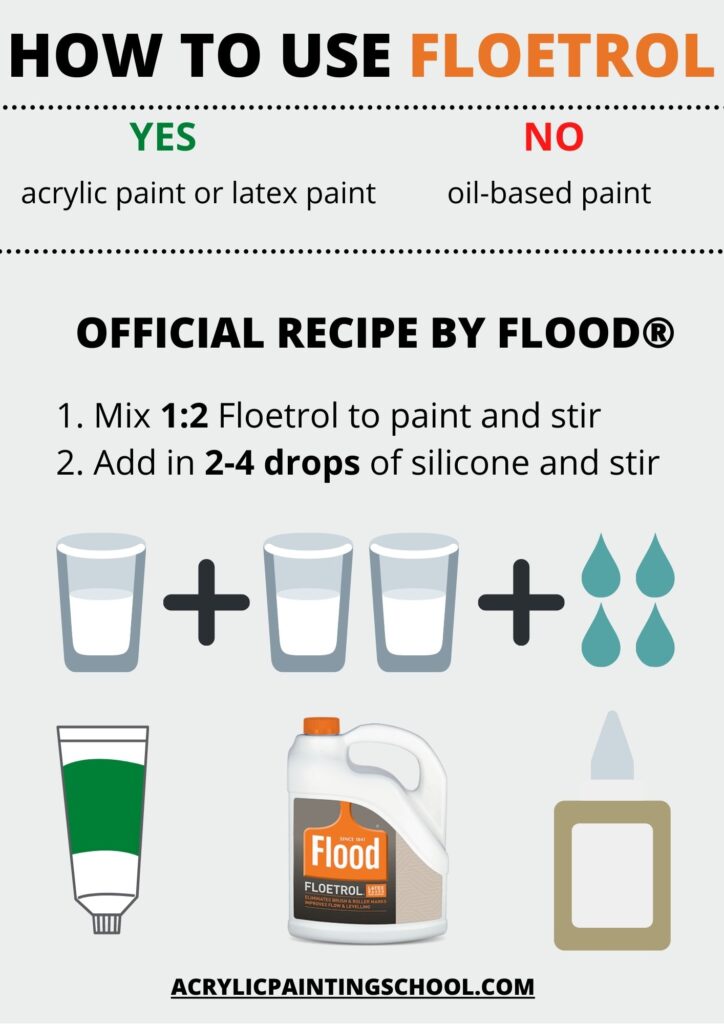
Please note, the official Flood recommendation to use 8 oz of Floetrol per gallon of paint DOES NOT apply for pouring, only for wall painting with rollers or brushes!
Recipe #1: Floetrol acrylic pour recipe recommended by the manufacturer
For each paint you will use, follow these steps:
1. Mix 1:2, 1 part of Floetrol to 2 parts of acrylic paint. 10 ml of Floetrol for 20 ml of paint.
2. Stir thoroughly
3. Add in 2-4 drops of liquid silicone (optional)
4. Stir thoroughly
Mix each color in separate cups. Otherwise, the paint will mix together.
If you use Floetrol for interior or exterior surfaces with a brush, roller, or sprayer, follow official guidelines from the Flood manufacturer. You can find them in this PDF
Practical tip:
Painters use a ratio of 20% to 50% Floetrol to acrylic paint for pouring based on their tests, specific acrylic paint they use, and experience – meaning 10 ml is 50% of 1 part (100%) of 20ml paint.
Does it make sense?
It may get confusing, I know, but unfortunately, painting is not as accurate as baking and we always need to test 🙂
More recipes that may or may not work as every paint and everyone’s experience is different, but they are widely used:
Recipe #2: Mixing acrylic paint with floetrol and distilled water
- Mix 1.5:1 Floetrol to acrylic paint
- Add 0.5 part distilled water
Distilled water is used in general to prevent any molding, contamination, and residue that tap water can have. If you don’t have and won’t buy distilled water, you can try boiling and cooling down tap water but I haven’t tested that.
Recipe #3: Danny Clark’s Recipe
- Mix 2:1:1 Floetrol to paint to distilled water
- Add 2-4 drops of silicone
Recipe #4: Mixing Floetrol with latex paint
Latex paint is a water-based paint.
It is made from acrylic resin as acrylic paint but usually is thicker. Acrylic paint is more flexible and durable because it contains other chemicals in it.
How to mix Floetrol with latex paint:
- Mix 1:3 Floetrol to latex paint for faux finishing
- If you are using latex wall paint with a brush or a roller, 8oz of Floetrol per gallon.
- With a cup spray gun 4 to 8 oz per quart of paint.
The best Floetrol alternative for pours is a professional pouring medium like Liquitex or Pebeo.
Read also: My Mont Marte Pouring Medium Review – There are better options
A homemade Floetrol can be made with Elmer’s glue and water but it won’t have any good properties of original Floetrol.
Mixing Floetrol with glue
The easiest craft way to enhance Floetrol at home is to mix approximately 1/3 floetrol, 1/3 water, and 1/3 white glue to make a pouring medium.
Once you mix it really well to make sure all ingredients are thoroughly submerged, strain the mix to avoid any lumps in your pour.
Then, you can mix this DIY pouring medium in a 1:1 ratio with regular acrylic paint.
For me it sounds excessive and I would not add glue to Floetrol as it can make all colors look matter, but people do that.
Where to buy Floetrol?
US Floetrol is produced by Flood brand while Floetrol sold in Europe is produced by the company Owatrol which was initially owned by Flood.
US Floetrol sold in US is called Floetrol, Owatrol’s Floetrol sold in US is called Easy Flow and it is the same product.
- Makes latex paints and primers flow more smoothly
- Eliminates brush and roller marks
- Improves the coverage of most paints
- Extends dry time so you can create finishing effects or correct mistakes
- Lubricates paint to reduce wear and tear on spray guns
- For US: Floetrol US 1 quart is around $13-14, Australian Floetrol can buy on Etsy in small bottles.
- For Canada: Floetrol US, Australian Floetrol
- For Australia: Australian Floetrol, Floetrol US
- For UK: Floetrol US, Owatrol Floetrol.
Floetrol is available in quantities of 1 Quart (946 ml), and 1 Gallon (3.78 L) and can be easily purchased from sites like Amazon and at paint stores like Home Depot and Lowes.
- Also, you can always purchase a ready-to-use starter set with all supplies you need.
Here is the link to the official website where you can also find a physical store near you. They do not sell floetrol on their website.
Floetrol FAQ
Is Floetrol archival?
Floetrol is not archival, meaning it can fade or yellow over time, but its substitute – Liquitex Pouring medium is actually archival.
Can you put Floetrol in primer?
You can only use Floetrol to thin water-based or latex-based primers but do not use Floetrol and oil primer together as they have very different consistency, composition, and purpose.
Will Floetrol change my paint color?
Floetrol doesn’t change acrylic paint colors once dry. It protects paint integrity and will not affect pigment. To make sure you can always test it before applying.
What is the Floetrol to paint ratio for an acrylic pour?
Floetrol suggests using a 1:2 ratio to mix paint for acrylic pour, for example, you need 25 ml of Floetrol for a 50 ml cup of paint.
How much floetrol to add to the paint?
You can add from 20% to 50% of Floetrol to acrylic paint, depending on how thick your paint is. For fluid paint add no more than 20% to have a liquid honey-like consistency. If your acrylic or latex paint is too thick you can add up to 50% of Floetrol to the mix.
What is Floetrol made of?
Floetrol is made of a latex-based paint additive that acts like acrylic or latex paint binder and some water.
That makes Floetrol ingredients compatible with acrylic paint. Floetrol doesn’t contain silicone oil.
What is Floetrol used for?
Floetrol is used in commercial projects and house painting to thin down latex paint and improve paint qualities, for ex., reduce brush strokes, rusting, damage to spray guns, etc. It is also today used for art as a pouring medium for fluid artworks.
Is Floetrol a pouring medium?
Floetrol was not designed for pouring but handy crafters realized that Floetrol’s properties and ingredients were perfect for pours and cells and began using it as a proper pouring medium.
What does Floetrol do to acrylic paint?
Floetrol thins acrylic paint for pouring to make it more liquid but without affecting its qualities like water. Floetrol makes acrylic paint more runny yet durable and homogeneous for pours.
How much Floetrol to add to latex paint?
For house painting add 8oz of Floetrol per gallon of latex paint. It will give perfect flow and make latex paint adhere to the walls and surfaces stronger.
Final Thoughts
Floetrol revolutionized acrylic pouring and in general paint thinning.
It made amazing cells possible even for beginners. But… we all know it comes with a price! Not everyone is ready to buy such an expensive medium just for fun.
Which makes us look at alternatives and homemade recipes.
Yet, as much as I love and support DIY, the majority of crafters agree that nothing quite compares to Floetrol, and not all pouring mediums give you cells!
If Floetrol is available in your country, I highly recommend testing it for pouring and cells let me know how it worked in the comments.

Masha Eretnova, born in 1991, is a Buenos Aires-based certified teacher, artist, and member of the Professional Artist Association with 20+ years of personal painting journey.
She started painting and drawing very early and is now an international abstract artist and educator passionate about acrylic painting, gouache, and crafts.
Her works are part of international exhibitions and contests, including ArtlyMix (Brazil), Al-Tiba 9 (Spain), Exhibizone (Canada), Italy, and many more.
Besides her artistic pursuits, Masha holds a post-grad diploma in Teaching Film Photography and 2 music school diplomas: piano and opera singing.
Last update on 2024-07-26 / Affiliate links / Images from Amazon Product Advertising API
